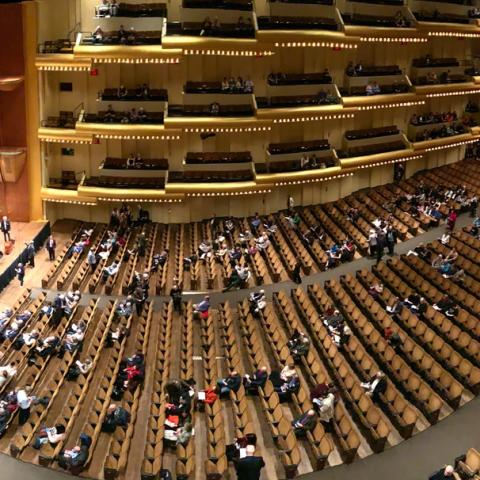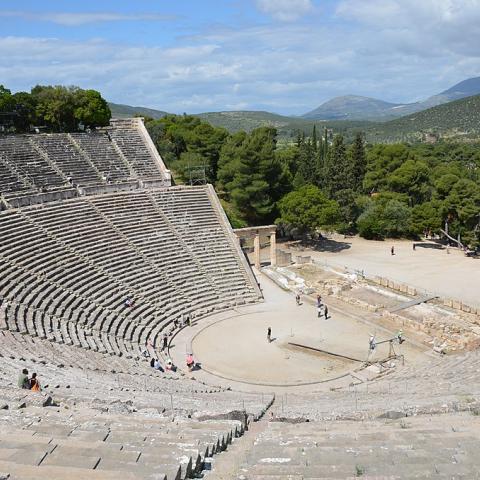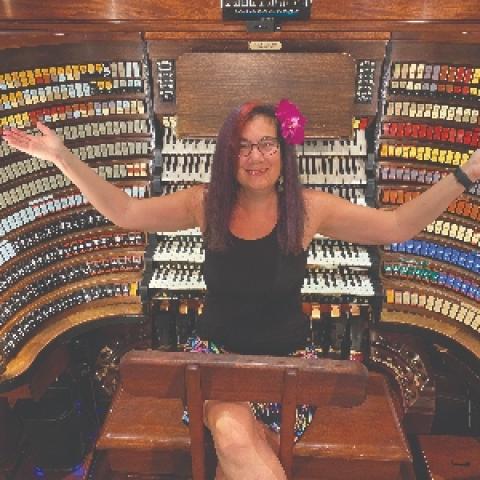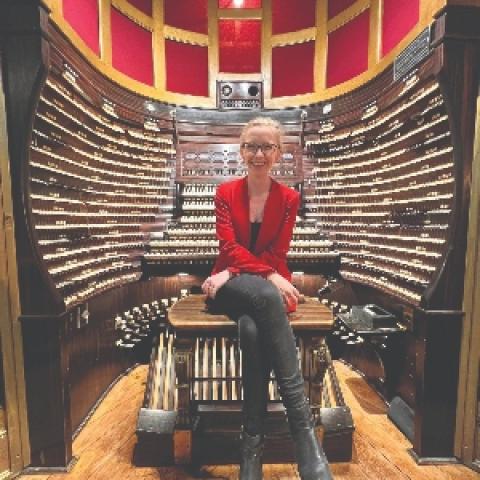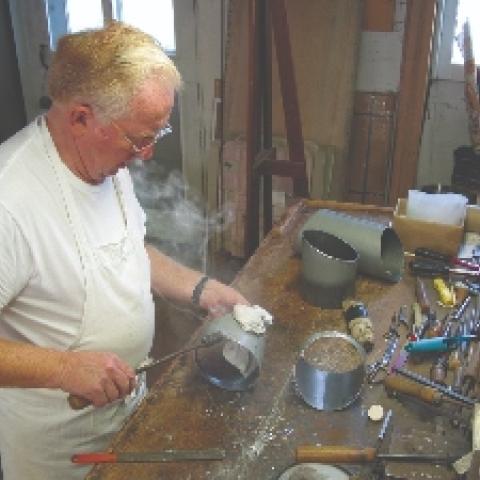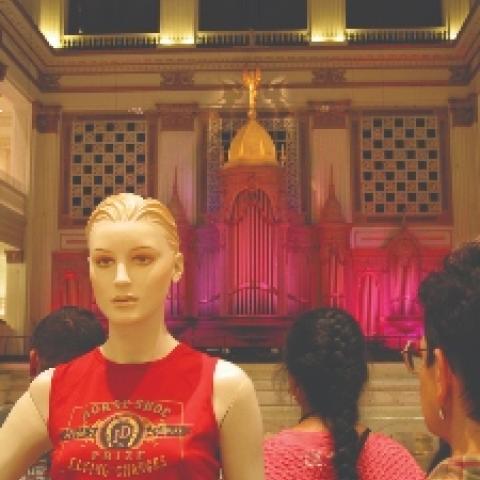
If a tree fell in the forest and there was no one there to hear it . . .
Suppose that we are sharing Christmas dinner. We are sitting with family and friends at a “groaning board” festooned with Granny’s stemware and china, ironed linen napkins, and the best silver, freshly polished. Red juices flow from the beef tenderloin as slices fall from the knife. Please pass the potatoes.
Over the clinking of silverware I happen to mention, “By the way, did you hear that all the churches will be closed for Easter?” Silence. “And not just Easter, Palm Sunday, and all of Holy Week.”
Shazam! I was right! To be truthful, I did not foresee it. No one did. According to Science Daily (April 9, 2020), by Christmas 2019, COVID-19 was more than a glimmer in the eye of a Chinese bat, but no one imagined that it would be spreading across the globe like wildfire a few months later. When my family and I left New York City for our house in Maine on March 14, there were fewer than 500 cases reported in the city. Three weeks later there were more than 20,000. Today, just one month later, there are over 110,000 confirmed cases with over 10,000 deaths in New York City alone. With the deadline for submissions to The Diapason six weeks before publication, writing these essays is no way to report the news. I am writing in mid-April, and you are reading in early June—plenty will have happened in the meantime. I hope some of it was good.
March 14 was the day Pope Francis announced that Saint Peter’s Basilica in Vatican City would be closed to the public and Easter Masses would be celebrated with no congregation. Thousands of churches around the world shared the example. The internet was rich with video clips of worship being led by two or three people in an empty church or by individuals participating in orders of worship individually from their homes, iPhone videos spliced together for broadcast on Sunday morning. Thousands of brass players and singers lost income. Hundreds of thousands of volunteer choir members missed the high point of the season. And thousands of preachers delivered Resurrection messages via their laptop screens.
The New York Chautauqua Assembly was an adult education, entertainment, and social movement founded by 1874 for the purpose of bringing cultural experiences to rural communities. Started as a summer camp on the shore of Lake Chautauqua in western New York, it grew to have chapters across the country. President Theodore Roosevelt commented that the Chautauqua Assembly was the most American thing in America. In the June 1883 issue of the journal, The Chautauquan, the question was posed, “If a tree fell on an island where there were no human beings, would there be any sound?” The essay went on to say, “No. Sound is the sensation excited in the ear when the air or other medium is set in motion.” I am not smart enough to second guess such an august source of philosophy, but my crude understanding of the science of noise is that sound is created by the vibration of air stimulated by some physical source and exists as sound waves that travel whether or not there is a receptor. That rhetorical question is reminiscent of Neils Bohr challenging Albert Einstein to prove there is a moon without looking at it.
Because of the widespread shutdown in response to COVID-19, we are learning a lot about working empty rooms. Late-night television hosts are trying to get big laughs while sitting in their living rooms. Symphony orchestras are presenting live broadcast concerts in empty halls. And we hear the peace and word of the Lord by way of a MacBook Pro, a church’s organist leading Zoom worship from his piano at home. All performing artists know that audience reaction is palpable. When you are playing before an enthusiastic crowd, you can feel the excitement, even if you are sitting with your back to them, buried behind a massive Rückpositiv case. Many of my performing friends have identified this as a challenge during recording sessions. Does your performance sound, feel, and project differently when the audience is absent? How do you get that fire in your belly when playing for a few recording engineers and a roomful of microphones? Part of the magic of public worship is sharing the experience with the people around you, both old friends and strangers.
I love the notion that congregational singing led by a pipe organ is a physiological phenomenon in which all the producers of tone are using the same body of air as fuel. What the singers exhale goes into the blower intake, and a great circle is established. That is not happening on Zoom.
Alternative worship
This phrase brings fear into the hearts of many organists, conjuring up images of guitars, drum sets, and songs with four notes, four chords, four lines, four stanzas, and four tuned strings. Several years ago, I was assembling the restored tracker action of a nineteenth-century organ, working toward an Easter deadline. The church’s contemporary ensemble needed to practice, and I needed the time, so we agreed that I would just keep working quietly inside the organ while they rehearsed. One thing was certain: they needed to practice. Another thing was certain: it didn’t help. Their rehearsal technique was to barge through a song four or five times compounding the mistakes and slapping each other on the back as if they had just finished their set at Woodstock.
But alternative worship can mean many different things. A little over twenty years ago, I was working on a project on the campus of UCLA and staying in a twenty-room hotel on campus that was operated by students in the hotel management school. The icy phone calls during which my first wife and I were separated happened when I was in that room. It was not a fun time.
I was interested in hearing and seeing the mammoth organ at the First Congregational Church in Los Angeles and planned to attend worship there on Sunday, but I was on Eastern time and woke up at three in the morning. Organ preludes would start at 10:30 a.m., so I figured I had plenty of time for a drive up the coast, thinking that some wind off the ocean would ease the darkness I was feeling. I do not remember just where I wound up. A glance at a map suggests it must have been somewhere between Ventura and Santa Barbara where I noticed a group of at least fifty people gathered on a bluff staring at the ocean with binoculars. I was curious—what would bring so many people together so early in the morning—so I parked my car and walked toward the group.
Someone welcomed me in and explained what was going on. The Los Angeles Chapter of the American Cetacean Society was counting migrating whales. There were tables set up with coffee and pastries. The people with binoculars were shouting out numbers while people with clipboards were recording them. There was a strong sense of comradery driven by a common purpose, and I quickly abandoned my plan of going to church. Standing by the ocean with a group of friendly people watching the glory of creation swim by was worshipful enough for me that day, lifting my spirits and clearing the mess from between my ears.
That singular Easter has just passed. We are all learning new ways to worship. Facebook is often a wormhole of self-satisfaction. I am not interested in your haircut or your magnificent meal. But I sure am interested in the dozens of posts I have read from colleagues sharing what it was like to participate in virtual Easter. Some showed clips of people dressed casually, leading a hymn from the piano in their living room, shifting to a pastor sitting at a desk leaning earnestly toward the screen speaking of the Resurrection “in this unusual time.” Others showed elaborately vested social-distancing priests at a high altar festooned with lilies, beeswax candles afire, a group of singers standing six feet apart, and the organist raising the dead with blazing trumpets.
Our rector in New York City spoke of taking a walk in abandoned lower Manhattan and seeing a small fleet of refrigerated trucks serving as temporary morgues behind a neighboring hospital. Realizing what they were and struck by the tragic loneliness of the scene, he stopped and offered a blessing. How’s that for an Easter message?
Resiliency
In the relative safety and serenity of our place in Maine, we have had two dramatic weather events in the last few days. In the afternoon of Holy Thursday, the wind came up, heavy rain turned to far heavier snow, the power went out, the generator came on, and the storm whipped through the night. On Good Friday, we woke to six inches of white wet glop, nearly impossible to walk on. Lichen-encrusted branches had fallen everywhere, and walking a few dozen yards up the driveway with a dog was like running a gauntlet with snow and debris falling from trees every few steps. The driveway is a half-mile long. It was grocery day, and I was planning to go to town. I put a saw in the car and spent a couple hours moving stuff off the road into the ditches.
The power was out all day, through Friday night, through Saturday night, and into Sunday afternoon, coming back on just as hundreds of colleagues would be launching into “the Widor” across the country. The head of our driveway is four miles down a rural road from the village, and the power lines snake through a maze of branches. There was a heavy ice storm shortly after we moved in the winter of 2001, and the power was out for nearly a week. That was when we installed the generator, and it has been a trusted part of the household since.
On Easter Monday, the rain started again, and the wind whipped up to gale force. The temperature was mild so there was no snow, but that storm stood out for the velocity and ferocity of the wind. The trees along the shore at the bottom of the yard were whipping wildly back and forth. After dinner I sat on the deck in the lee of the storm watching the crazy motion in the darkness and listening to the roar of the wind when it stopped. It did not lessen and die down. It just stopped. The roar became silence. The next morning, we confirmed that nothing new had fallen in the yard or on the driveway. After all that whipping about, no trees had fallen. Such resilience. Such strength. Such stability. A metaphor for facing life today.
In the 1964 film Mary Poppins, George Banks (played by David Tomlinson) works for the Dawes Tomes Mously Grubbs Fidelity Fiduciary Bank. He is the father of Jane and Michael, husband of Winifred, and Mary Poppins’s employer. He is a man of rigid routine. Early in the film, arriving home from the office, he sings:
I feel a surge of deep satisfaction
Much as a king astride his noble steed.
When I return from daily strife to hearth and wife,
How pleasant is the life I lead . . . .
. . . I run my home precisely on schedule.
At 6:01, I march through my door.
My slippers, sherry, and pipe are due at 6:02,
Consistent is the life I lead.
The trouble is that while he is singing, Winifred is trying to interrupt to tell him the children are missing.
I can hear Wendy snickering. Cocktails here are at six-oh-oh. Dinner at eight-oh-oh. The routine is regular enough that Farley the Goldendoodle can tell time. “Paws up” on the bed at 6:30 in the morning. (That is the only time he ever gets on furniture.) A couple minutes before cocktails, he is sitting watching me. He gets an ice cube or two when I am fixing drinks and a dental “chewy” when we sit down with them. He depends on that routine as much as I do. We have laughed about it many times. Sometimes wryly.
But consistent no more. Our daughter, son-in-law, and granddaughter who live in Brooklyn, New York, came to Maine with us—and their dog. Remembering those refrigerated trucks, we are glad we can offer them shelter from the ravages of the city. We are four adults, a toddler, and two dogs, and the quiet, comfortable routine of two empty nesters is on sabbatical, if not just gone. We are five weeks into it now, and I have had some tough moments adjusting. But think of our Brooklynites. At least we are at home. We have lived in this house for almost twenty years, the longest either of us have lived in one place. We have clothes in the closets, unread books on the nightstands, extra toothbrushes in the drawers in the bathroom. It is familiar. They have left their home behind, all their daily routines, and all their stuff. We are coming up with new common daily rhythms, and the great news is that we are getting more time with our granddaughter than we could have imagined.
The new normal
I wonder when things will go back to normal. I wonder what the “new normal” will be. We were living in an unusual time before the start of the pandemic. Yesterday, CBS News reported that this is the first March since 2002 without a school shooting in the United States. Why? Simple. Schools are closed. Every significant arts organization in the country is closed. Thousands of orchestral musicians, actors, stagehands, ushers, and administrators are out of work. When the Metropolitan Opera laid off its entire staff with pay ending on March 31, I wondered if that fantastic assembly of talented skilled people could ever be gathered together again? But it is not as if disgruntled, they would take other jobs. There are no other jobs.
I can imagine sitting down again with trusted friends for a drink or a meal, maybe not so long from now. I can imagine taking an unessential drive to a park for a picnic. I can even imagine booking a hotel room and working on a job away from home. But knowing how I feel when I have to walk past an unmasked stranger in a grocery aisle, I cannot imagine walking through a foyer into a crowded theater or concert hall, exposing myself and those I love to whatever foolish indiscretion a seatmate might have committed. I assume I will go to a concert again, but I cannot imagine it yet. A vaccination against COVID-19 must be the greatest brass ring for medical research since polio.
The community of the church choir has always been a source of recreation and spiritual enhancement. In a video interview produced by the publisher J. W. Pepper in 2015, composer and conductor John Rutter says, “. . . choral music is not one of life’s frills. It is something that goes to the very heart of our humanity, our sense of community, and our souls.”1 I first sang in a children’s choir in 1966 when I was ten years old. I have vivid memories from a few years later of using my new grown-up voice as a member of the adult choir singing Bach’s Cantata 140. (Va-ha-ke-het auf, Va-ha-ke-het auf, Va-ha-ke-het auf—two, three, one—ruft die Stimme!) I trust that future generations will have similar thrills, knowing the joy of singing closely with others.
In this column in the May 2017 issue of The Diapason, I wrote under the title, “Music in terrible times.” Wendy and I had just heard the Boston Symphony Orchestra play Shostakovich’s Leningrad Symphony. I started that essay with Leonard Bernstein’s famous quote from the Vietnam era: “This will be our response to violence: to make music more intensively, more beautifully, more devotedly than ever before.” I wrote of the siege of Leningrad in which more than a million people died, a battle that inspired Shostakovich’s masterpiece. I wrote of the bombing of Coventry, England, in 1940 from which came Benjamin Britten’s War Requiem. I wrote of Stalag VIIIA where Olivier Messiaen was a prisoner of war and a sympathetic guard provided him with pencil and paper, allowing him to create Quartet for the End of Time.
Those great masterpieces are all the expressions of creative geniuses responding to vast human crises. The people who lived those days must have wondered if it would ever end. And horrible as they were, they all did end. Many people suffered, many people died, families were destroyed, and dreams were shattered. I trust that we will see each other at the symphony again. We will go to the theater again. We will go to ball games again. We will go sailing again. For now, we have to stay strong, take care of the people we love, and nourish the creativity within.
Now go practice while you have a chance.
Notes
1. You can see the interview at https://www.youtube.com/watch?v=pm-Pm1FYZ-U.
Photo: John Cantrell, choirmaster and organist, St. Michael’s Episcopal Church, New York, New York. John records rehearsal tracks for choir members, they practice and send in their videos, and he mixes them into a virtual choir, adds readings recorded by parishioners at home, sermon, and voilà! (Photo credit: Kathleen Cantrell)

